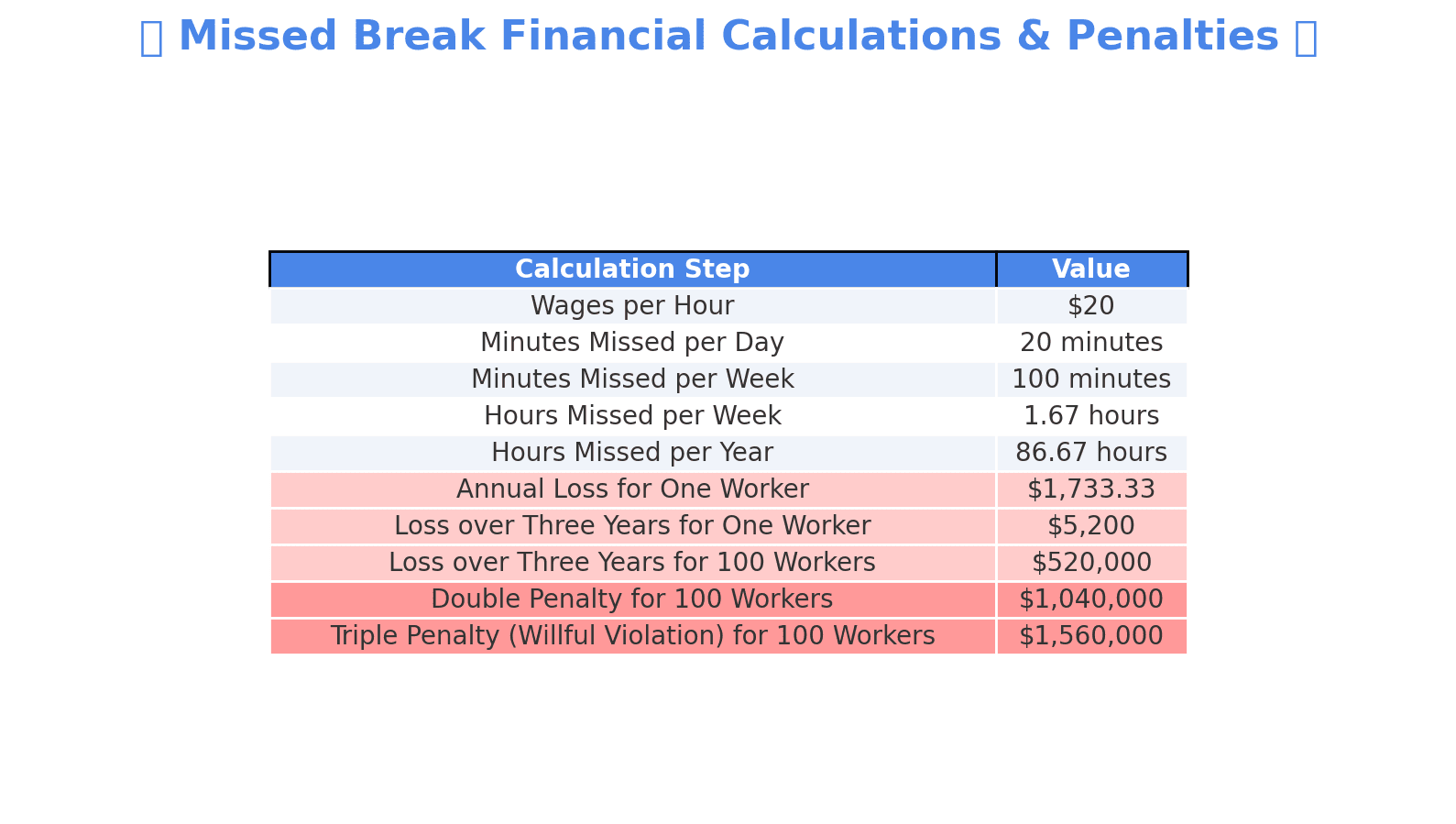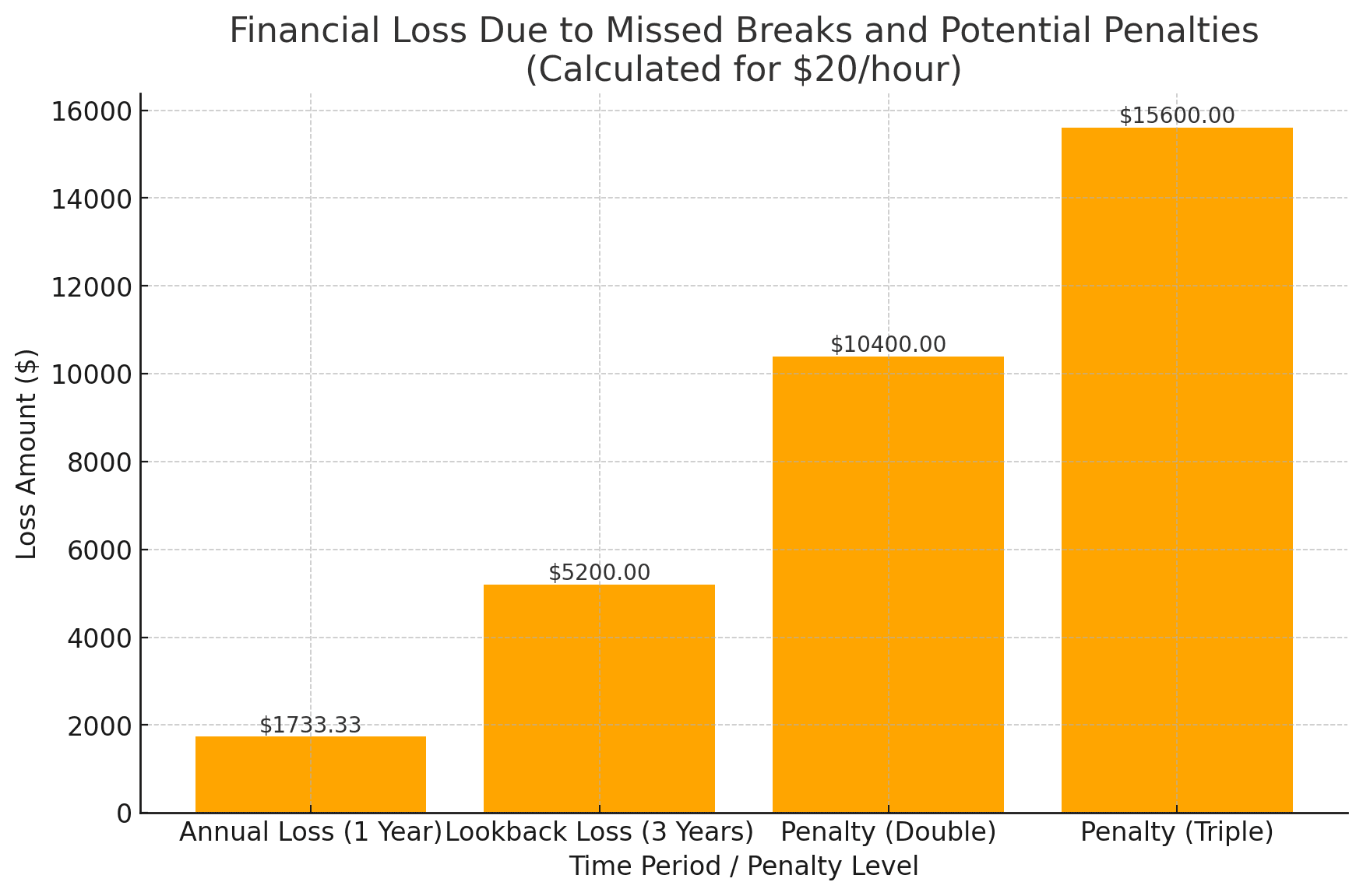
When you’re connected to an industry like healthcare, ensuring employees receive proper breaks is essential. It is not just for their well-being, but for the quality of care they provide. Yet in many clinics across Colorado, healthcare workers endure long shifts with insufficient or denied breaks.
This often ends up leading to physical and mental strain that can compromise both staff health and patient safety. Given the support these heroes provide, the last thing they should have to worry about is break violations in healthcare. In fact, we should all work together to ensure that these issues are resolved.
It is essential for healthcare providers to recognize the power they hold within the system and how they can come together to shift industry trends and overcome challenges in this field, ultimately influencing the quality of life for future generations of heaalthcare workers and patients alike.
We’ve all seen patients talk about unintentional HIPAA violations or mistakes, but people hardly discuss the hardships on the healthcare professional’s side. So, let’s look break violations in Colorado, what they do, and the legal pathways available to affected employees.
Unpaid Breaks in Healthcare Settings
Healthcare workers, especially those on 10-hour or longer shifts, are entitled to regular breaks. This can be for a meal period, and doesn’t break any HIPAA laws.
On the other hand, for a 10-hour shift, Colorado law mandates three breaks: two shorter breaks and one meal break. However, in reality, many clinics fail to honor this standard.
This is particularly prevalent in understaffed clinics where pressing patient needs often override scheduled rest times. Employees are sometimes told to “find time for breaks,” an impractical expectation in a work environment where each moment is critical.
The consequences of these violations are significant. Continuous hours without rest lead to fatigue, diminished focus, and elevated stress levels—all of which can compromise patient care and the safety of the healthcare staff.
Over time, the lack of adequate breaks leads to burnout, high turnover rates, and even injuries, which ultimately increase the operational strain on the clinic and impact patient outcomes. In some cases, employees end in trouble, even though they try their best to avoid patient harm.
Despite wanting to provide human services to clients, handling medical records, avoiding common HIPAA violations and limiting meal periods, professionals often end up with fatigue.
Legal Framework and Protections for Healthcare Workers: Overview of Relevant Labor Laws
While there’s criminal provision for acts like willful neglect and breaking HIPAA regulations, the FLSA often ends up getting ignored in all the complications of work. Healthcare facilities that want to stay away from criminal liability should look into the Fair Labor Standards Act, which clearly explains:
Fair Labor Standards Act (FLSA):
Employers are required to compensate employees for short breaks (10 minutes or less), counted as work hours.
Meal breaks of 30 minutes or more don’t need to be paid, as long as the employee is fully relieved from duties.
Colorado Wage Order 38:
Employees working shifts over 5 hours are entitled to a 30-minute unpaid meal break.
For every 4 hours worked, employees must receive a 10-minute paid rest break.
For healthcare staff on 10-hour shifts, this means they should receive at least one meal break and three paid rest breaks.
Employers cannot require employees to find their own time for breaks; it’s the employer’s responsibility to ensure these breaks are provided.
Healthcare Worker Classification and Break Entitlements
Proper classification of healthcare workers is essential to ensure they receive legally mandated breaks:
Non-Exempt vs. Exempt Employees:
Non-Exempt Employees: Typically include hourly healthcare support staff (like nurses, medical assistants, and technicians), who are entitled to overtime pay and breaks.
Exempt Employees: Generally salaried and higher-level roles that may be excluded from certain wage protections, including mandatory breaks.
Common Misclassification Issues in Healthcare:
Some healthcare workers performing non-exempt duties are misclassified as exempt, potentially depriving them of their entitled breaks and overtime pay.
Misclassification can leave healthcare employees vulnerable to overwork, lack of compensation, and fatigue, as they may miss out on break protections.
Steps for Healthcare Employees: What You Need to Know
Know Your Rights: Understanding whether you’re classified as non-exempt or exempt can help clarify your eligibility for breaks.
Seek Clarification: If you believe you’re misclassified, ask for clarification from HR or management.
File Complaints: Misclassified employees who are denied breaks may have grounds for legal action or a Department of Labor complaint.
Real-World Case Example: “PNC”
To understand the tangible impact of these violations, consider the story of “PNC,” a healthcare worker who faced this issue firsthand. Despite working long shifts in a high-demand clinic, PNC was not granted designated breaks. Her manager and HR told her to manage her own time, even for basic needs like restroom use.
After enduring this treatment and witnessing no change despite repeated complaints, PNC took action. In October 2023, she filed a complaint with the Colorado Department of Labor. The department found she was owed $260 in back pay for missed breaks.
Additionally, she was awarded a $1,500 penalty due to delayed payment, reinforcing the importance of timely compensation for missed breaks.
PNC’s case sheds light on a broader issue within her clinic’s network, which operates 10 locations. If these practices are consistent across multiple sites, employees could be eligible to join a class action lawsuit. The potential value of such a suit might range from $1-3 million in unpaid wages and penalties, plus additional legal fees.
The Potential Scope of a Class Action Suit and Precedents
Examples of Similar Lawsuits
Class action lawsuits in healthcare have been instrumental in addressing labor violations, including unpaid breaks and overtime. In recent years, several notable cases have set significant precedents:
Dignity Health Settlement (2018):
In California, healthcare workers from Dignity Health filed a class action alleging that they were denied legally mandated meal and rest breaks. The lawsuit resulted in a settlement exceeding $7 million, benefiting thousands of employees who missed breaks or were not paid for them.
This case underscored the rights of healthcare employees to take regular breaks and illustrated the financial impact of collective legal action.
Kaiser Permanente Class Action (2020):
In another high-profile case, healthcare workers at Kaiser Permanente alleged they were forced to work through their meal and rest breaks without compensation. The resulting settlement reached over $11 million, highlighting that even well-established healthcare systems can be held accountable for break violations.
Hospital Corporation of America (HCA) Settlement (2022):
A group of nurses filed a class action lawsuit against HCA, claiming they were required to perform work duties during unpaid breaks and were often understaffed. The settlement of $13.5 million not only provided financial compensation to employees but also pressured HCA to review its break policies to ensure future compliance.
These cases show that when healthcare workers unite in class action lawsuits, they can secure substantial settlements that compensate for lost wages and deter further violations by holding employers accountable.
Role of Collective Action in Policy Change
Class action lawsuits do more than secure compensation for individual workers—they drive broader industry change by setting legal precedents and pushing employers to reform their practices. When a healthcare organization is forced to settle or face a costly legal battle, it sends a message across the industry that labor violations have serious repercussions.
Key impacts of collective action include:
Setting Legal Precedents: Successful class actions establish case law that other workers can reference if they face similar issues, effectively strengthening the legal framework that protects employee rights. This deters future break violations by setting a high standard of accountability for employers.
Encouraging Stricter Enforcement: Large settlements bring attention to industry-wide issues, often prompting stricter enforcement of labor laws. In the wake of these cases, regulatory bodies may conduct more rigorous audits and investigations, ensuring compliance and discouraging clinics from violating labor laws.
Promoting Workplace Policy Reform: Class actions not only result in compensation but often require the defendant organization to adjust its policies as part of the settlement. These policy changes, such as implementing regular rest breaks or scheduling adjustments, directly improve the working conditions for current and future employees.
Damages and Compensation for Healthcare Workers in Break Violation Cases
When healthcare workers pursue legal action against clinics or healthcare organizations for break violations, they may be eligible for various types of compensation.
These damages not only help to recover unpaid wages but also serve as a deterrent to prevent future violations. Here’s a breakdown of the potential damages and compensation healthcare workers can expect:
1. Unpaid Wages for Missed Breaks
Compensation for Lost Time: Workers may receive back pay for missed breaks, calculated based on the number of breaks missed over time. For instance, if an employee was denied two 15-minute breaks per shift, this time can be quantified and compensated according to the worker’s hourly wage.
Lookback Period: Many states, including Colorado, allow a “lookback period” of up to three years. This means employees can claim unpaid wages for all missed breaks within that time frame, allowing for significant back pay in cases of ongoing violations.
2. Overtime Compensation
If break violations resulted in employees working additional hours that should have been counted as overtime, they may be entitled to compensation at a higher overtime rate. This applies to non-exempt employees who worked beyond the standard 40-hour workweek due to missed breaks.
3. Penalty Damages
Double or Triple Damages for Willful Violations: In cases where the court finds the violation to be willful, penalties can multiply the back wages owed. For instance, if an employer knowingly failed to allow legally required breaks, the court may award two or even three times the unpaid amount as punitive damages.
State-Specific Penalties: Some states have additional penalties for break violations, such as mandatory daily fines for each missed break. In Colorado, clinics that fail to provide required breaks may face substantial penalties under the state’s labor laws, which are awarded to the affected employees.
4. Emotional Distress and Mental Anguish
Healthcare employees who experienced severe mental strain or burnout due to relentless shifts without adequate rest may be eligible for compensation for emotional distress.
Although more challenging to quantify, this damage reflects the psychological toll of break violations, especially in high-stress, high-stakes healthcare settings.
5. Attorney’s Fees and Legal Costs
When an employee wins a labor violation case, the clinic or healthcare organization may be required to cover the employee’s attorney fees and legal costs. This ensures that workers are not financially burdened for seeking justice and encourages others to come forward if they are facing similar mistreatment.
6. Injunctive Relief and Policy Changes
Courts can also issue injunctive relief, mandating that the employer change its break policies to ensure future compliance. This may include implementing a break schedule, hiring additional staff to cover breaks, or regular audits to verify adherence to labor laws. Such changes can help protect current and future employees from enduring similar violations.
Potential Total Compensation
In cases involving systemic violations across multiple shifts, locations, or employees, total compensation can reach millions of dollars.
Collective actions, like class action lawsuits, can significantly increase the financial impact on the clinic, benefiting a broader group of affected healthcare workers and setting a precedent to improve conditions across the industry.
By pursuing these damages, healthcare workers can not only reclaim their rightful compensation but also drive meaningful change within the healthcare system, creating safer and fairer work environments for themselves and future generations.
Common Healthcare Labor Violations
Break violations in healthcare clinics are not isolated. Other common labor issues that healthcare workers encounter include:
Forced Desk Meals: Many healthcare employees are forced to eat their meals at their desks while continuing to work. This practice deprives them of genuine breaks and compounds mental and physical fatigue as they are unable to disconnect from patient care even momentarily.
Uninterrupted Schedules: In many clinics, especially those facing staffing shortages, schedules often don’t allow time for designated break periods. Employees work continuously throughout their shifts, with little to no relief, which can quickly lead to burnout. This lack of structured break times pushes staff to work in high-stress, high-demand environments for hours without respite.
Unpaid Work During Breaks: Healthcare workers may be required to remain on-call or perform tasks during their designated break times, essentially working without pay. This might include checking on patients, completing documentation, or handling phone calls. Such practices violate labor laws that mandate paid breaks if employees are required to be available for work during those times.
These violations, particularly when sustained over time, lead to significant mental and physical wear, affecting the overall performance and morale of healthcare employees.
Industry-Specific Challenges
Healthcare labor violations are especially common due to unique challenges in the industry:
Chronic Staffing Shortages: Persistent staffing shortages mean fewer employees must cover the same patient load, leaving little room for breaks without compromising patient care. This shortage often pressures clinic managers to require longer work periods from staff without guaranteed rest, leading to overwork and fatigue.
High Turnover Rates: High turnover rates in healthcare create a continuous cycle of onboarding and understaffing, often disrupting break schedules as new staff adjust to patient demands. Clinics may also rely heavily on existing staff to cover shifts, reducing the chance of regular break times as employees fill in for one another.
Low Operating Margins: Many clinics operate on slim margins, which can lead to cost-cutting measures like reducing staff or skipping paid breaks. In an attempt to maximize productivity, clinics may forgo providing sufficient coverage that would allow employees to take their entitled rest periods. This approach, while financially appealing in the short term, can result in higher turnover and potential legal expenses over time, highlighting the false economy of neglecting labor standards.
Financial Implications of Break Violations

Break violations can have substantial financial consequences for healthcare workers. Here’s how these violations impact employees and clinics financially:
Calculation of Unpaid Breaks: For a healthcare worker earning $20 per hour, missing two 15-minute breaks daily results in 30 minutes of unpaid work each day. Over a typical work year, this equates to approximately $5,200 in lost wages—a significant financial burden on the worker.
Potential Penalties for Clinics: If break violations are deemed willful, Colorado law may impose penalties of double or even triple the owed wages. This means that for the $5,200 lost annually by an employee, the clinic could be required to pay up to $15,600 per affected worker, reflecting the severity of these violations and incentivizing adherence to break regulations.
Three-Year Lookback Period: Colorado labor laws provide a three-year “lookback period” during which affected employees can claim unpaid wages for every missed break.
This provision allows healthcare workers to recover lost wages for violations sustained over time, which can result in additional penalties and legal fees for clinics if these issues persist.
Break violations impose substantial financial burdens on employees. To illustrate, consider a healthcare worker earning $20 per hour who is consistently denied two 15-minute breaks per day. This equates to 30 minutes of unpaid work each day, totaling around $5,200 in lost wages per year.

Protect Your Rights and Take Action
Healthcare workers facing break violations do not have to endure these conditions alone. Clinics that systematically deprive employees of their legal right to breaks can be held accountable, potentially through a class action lawsuit. By coming together, healthcare employees can challenge these practices, securing both financial compensation for unpaid breaks and fostering a healthier work environment for future employees.
If you’re facing these challenges, it’s time to take a stand. Bourassa Law Group is here to support you during this difficult time. Book a free consultation today, and let us help you fight for the rights and compensation you deserve. Together, we can hold clinics accountable and ensure that you’re treated with the respect and dignity you’ve earned.





